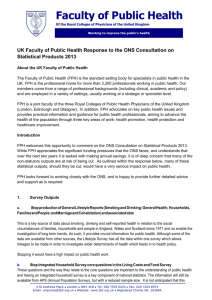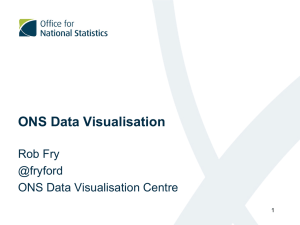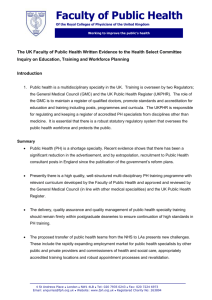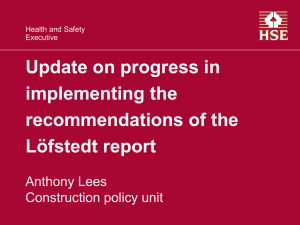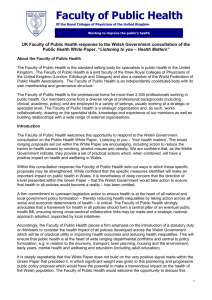European Standard Population
advertisement
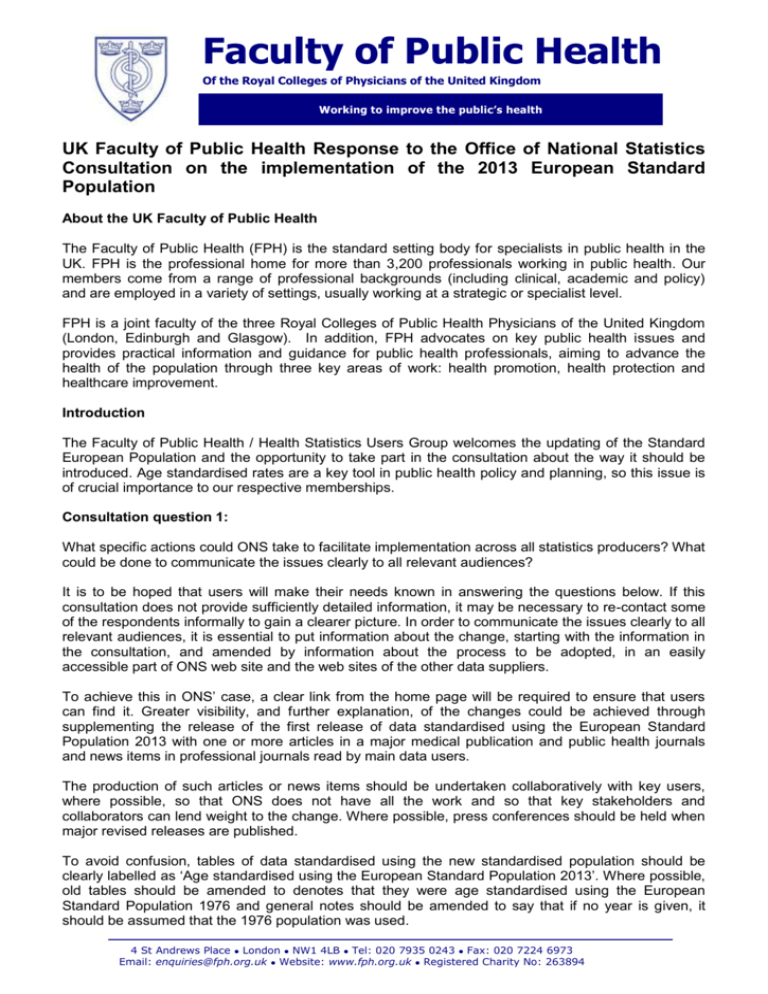
Faculty of Public Health Of the Royal Colleges of Physicians of the United Kingdom Working to improve the public’s health UK Faculty of Public Health Response to the Office of National Statistics Consultation on the implementation of the 2013 European Standard Population About the UK Faculty of Public Health The Faculty of Public Health (FPH) is the standard setting body for specialists in public health in the UK. FPH is the professional home for more than 3,200 professionals working in public health. Our members come from a range of professional backgrounds (including clinical, academic and policy) and are employed in a variety of settings, usually working at a strategic or specialist level. FPH is a joint faculty of the three Royal Colleges of Public Health Physicians of the United Kingdom (London, Edinburgh and Glasgow). In addition, FPH advocates on key public health issues and provides practical information and guidance for public health professionals, aiming to advance the health of the population through three key areas of work: health promotion, health protection and healthcare improvement. Introduction The Faculty of Public Health / Health Statistics Users Group welcomes the updating of the Standard European Population and the opportunity to take part in the consultation about the way it should be introduced. Age standardised rates are a key tool in public health policy and planning, so this issue is of crucial importance to our respective memberships. Consultation question 1: What specific actions could ONS take to facilitate implementation across all statistics producers? What could be done to communicate the issues clearly to all relevant audiences? It is to be hoped that users will make their needs known in answering the questions below. If this consultation does not provide sufficiently detailed information, it may be necessary to re-contact some of the respondents informally to gain a clearer picture. In order to communicate the issues clearly to all relevant audiences, it is essential to put information about the change, starting with the information in the consultation, and amended by information about the process to be adopted, in an easily accessible part of ONS web site and the web sites of the other data suppliers. To achieve this in ONS’ case, a clear link from the home page will be required to ensure that users can find it. Greater visibility, and further explanation, of the changes could be achieved through supplementing the release of the first release of data standardised using the European Standard Population 2013 with one or more articles in a major medical publication and public health journals and news items in professional journals read by main data users. The production of such articles or news items should be undertaken collaboratively with key users, where possible, so that ONS does not have all the work and so that key stakeholders and collaborators can lend weight to the change. Where possible, press conferences should be held when major revised releases are published. To avoid confusion, tables of data standardised using the new standardised population should be clearly labelled as ‘Age standardised using the European Standard Population 2013’. Where possible, old tables should be amended to denotes that they were age standardised using the European Standard Population 1976 and general notes should be amended to say that if no year is given, it should be assumed that the 1976 population was used. 4 St Andrews Place London NW1 4LB Tel: 020 7935 0243 Fax: 020 7224 6973 Email: enquiries@fph.org.uk Website: www.fph.org.uk Registered Charity No: 263894 Consultation question 2: Which option for planning implementation should ONS and other official statistics producers follow, and why? When should implementation begin/take place/be completed by, and why? Option 1 is impractical, especially given the reduction in capacity of ONS’ health statistics staff. Option 2 will not make it clear to users when to expect each update. Option 3 is preferable as it can be integrated into ONS’ practice of pre-announcing its release dates. It would be helpful if each of the data providers published their first release on the same date and published the timetable for the subsequent releases on their web sites as well as adding amendment sheets to each existing publication to give the timetable for the updates. It is worrying to see that all the outputs from the Office for National Statistics appear in the list of outputs which may be discontinued in the ONS Consultation on Statistical Products to which we shall also be submitting a response. We are concerned that the additional work needed to update them to implement the European Standard Population may put them at additional risk. Consultation question 3: Would revision of time series back to 1994 (or later for series started subsequently) meet most user needs, and what are the exceptions? It is not possible to generalise as to whether this would meet user needs. The rationale given for selecting 1994 as a mid-point between the old and new standards appears to be a sound, but the views of organisations and individuals with specialist needs should be sought, since it is likely that longer time series would be required for certain conditions, such as those associated with environmental exposures that may have changed over time. Consultation question 4: What are the most important time series to revise, and why, in order of priority and for what geographies? There would be value in prioritising those series that are used most frequently to inform for policy and resource allocation decisions or are used for international comparisons, and those that cover the wider ranges of diseases/conditions. It would be important to revise all indicators related to a particular disease or condition or geography at the same time (subject to the caveat below, related to timing of publication) to ensure that misleading comparisons are not drawn. A pragmatic approach to prioritisation could be to revise time series according to the date of publication i.e. revising those with the earliest publication date over those with later publication dates. Consultation question 5: Is there a strong case for implementation of different upper age bands at different geographical levels, and if so why? It would be desirable to use the full range where numbers permit, but to amalgamate upper age groups if numbers in the numerator are small. We recognise that there are also constraints related to the production of population estimates and that these commonly use a single group for the 90 plus age group. To avoid the risk of inappropriate comparisons arising from differences in amalgamating older age groups, producers should be clear about whether their figures are based on amalgamation of upper age groups. 4 St Andrews Place London NW1 4LB Tel: 020 7935 0243 Fax: 020 7224 6973 Email: enquiries@fph.org.uk Website: www.fph.org.uk Registered Charity No: 263894 2 Do you have any other comments? While it is noted that “ONS is not consulting on the principle of whether to implement the change, as the ESP is a Europe-wide standard methodology which UK producers of official statistics are expected to follow”, the Faculty of Public Health would note that in its consultations with Faculty members the rationale for adopting the change, and the cost utility of doing so, was challenged. There is an extensive literature covering a wide range of diseases/topics in which authors have standardised to the European standard population precisely so that comparisons can be made between different studies in different places at different times without any need to re-calculate rates (even if the data were available to do so). While revising national statistical outputs would enable comparisons between those national data sets and comparison with other international data sets produced according to the same standard (but only to 1994 if the proposal to limit revision to that date is followed through), it will make comparison to the a large body of valuable published statistics in the scientific literature practical impossible. 4 St Andrews Place London NW1 4LB Tel: 020 7935 0243 Fax: 020 7224 6973 Email: enquiries@fph.org.uk Website: www.fph.org.uk Registered Charity No: 263894 3


